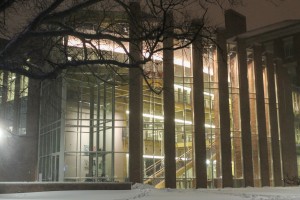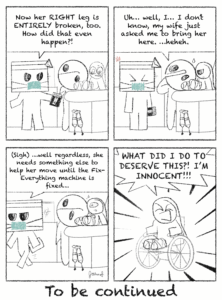UR is particularly well-known for being forward in thinking when it comes to sustainability. Just this year, it ranked 6th on the 2014 list of 75 Best Colleges for Food in America by The Daily Meal.
One of the categories used to judge dining centers was “Nutrition and Sustainability,” rating “each college on this list makes consistent efforts to ensure that their food is well-balanced, as well as tasty, and is healthy not just for the students, but for the environment as well, according the The Daily Meal website.
The University has taken strides towards becoming more sustainable in many different areas, from transportation to construction to student access, and many others.
Hugh Kierig, the Director of Parking and Transportation, talked about a few different programs that the Parking and Transportation is working on. UR Connections, for example, is in place to promote alternate transportation to get to campus and to get around the community in a sustainable way while reducing campus congestion.
“It includes programs such as [car and van] pooling and promotion of the university shuttle services, the RTS system, Zipcar, and the promotion of biking/walking as transportation modes and not just as a recreational activity,” he said.
Kierig also discussed two projects that the department and University are working on with the city of Rochester that will connect the River Campus with the rest of the city.
One of them is developing a bicycle track that would run parallel to Elmwood Rd. extending from the River Campus to Brighton. It would be a secondary sidewalk strictly for bicycles.
“It’s designed to cater to bicyclists so they can travel outside the traffic lanes safely,” Kierig added. “We’re just initiating the engineering study for it, so it’s going through the first phase of all of the engineering requirements, [such as] how it should be constructed and where the crossings would be.”
The department is also working on developing a bike sharing program, similar to Zipcar.
“Students can rent a bike at the River Campus and ride it to downtown or to Park Ave, leave it there – there are [designated racks] where you can store the bike – and when you’re ready to ride again you can take another bike and ride it back to campus,” Kierig said. “It would be citywide at a variety of highly concentrated areas that a student would want to go.”
The fact that this program would have various rental racks around the city would differentiate it from City Cycles, which is based only at the River Campus.
In the classroom, the EcoReps have spent the last month researching energy and new technologies and programs could be easily implemented and work on the Rochester campus. These specifically include plastic bag reduction on campus and an EcoRep-type program for faculty and staff.
According to Earth and Environmental Sciences Professor and co-chair of the University Council of Sustainability Karen Berger, the University is increasingly keeping sustainability in mind, especially in construction practices.
“We are constantly assessing what standards we have within the building office,” Berger said, based on Leadership in Energy and Environmental Design (LEED), a standard used in construction that addresses eco-friendly building practices.
“Part of certifying buildings as LEED Certified is having people who design and engineer the buildings be trained…so even if the building isn’t LEED certified, it’s still designed with those principles in mind, such as maximizing daylight and reducing energy,” Berger said.
Saunders Research Building in the Medical Center and O’Brien Hall are the two LEED certified buildings at UR.
UR also receives grants through NYSERDA (New York State Energy Research and Development Authority) to help to reduce the energy footprint. Most recently, the University received a significant grant to improve energy efficiency on campus.
Each little effort that the University makes around campus adds up. For example, the grounds are managed using integrated pest management instead of just using pesticides, which helps reduce chemical usage and promotes a step-by-step response to pests; they use chemicals as a last resort.
Dining also keeps in mind where they are purchasing their food from and the connections they have with the local farms from where they’re purchasing.
The Biomedical Engineering and Optics building Goergen Hall was designed by LEED standards, and it is clearly set apart from other buildings.
The building was constructed so that the area on each floor that has natural light is maximized with the use of efficient windows, as well as installing many motion sensors to make the use of lights more efficient. All of the water from the roof goes to a rain garden between Goergen and Hutchison Halls, and the wood used is bamboo, which is considered renewable and therefore a sustainable building product.
Academically, many students have also gotten involved in promoting sustainability.
EcoReps, a group of incoming freshman who work to learn about sustainability, and are put in charge of a freshman floor to educate their peers about environmental issues in addition to encouraging good sustainable practices.
Sustainability projects that EcoReps is currently working on include installing several permanent recycling bins for plastic bags on campus, placing more cigarette dispensaries on campus, and creating a “green office guide” to inform different departments on campus about how they can go about being more sustainable.
Furthermore, a handbook is being created to aid with the formation of a faculty “EcoRep”-type program, according to sophomore and EcoRep coordinator Jake Post.
According to the website, Facilities Team Green is another student-led group that aims to “increase education and awareness of sustainability among the University of Rochester community,.”
The team is currently in the process of planning Recyclemania, a nationwide intercollegiate competition to see which college or university can recycle the most, which will be occurring next semester.
“For eight weeks, we’ll be having a different sustainability theme in collaboration with other green groups on campus,” Sophomore and Facilities Team Green member Linda Shackles said. Other environmentally-conscious student groups on campus include the Microfarm, Greenspace, Dining Team Green, and Grassroots.
Every UR student can take pride in the fact that the campus truly puts all of its efforts into become a more environmentally conscious space in which students can come together and make a difference. There are many avenues by which to help students become sustainable in their practices and reduce their footprint. Best of all, these avenues are all within hands reach.
Kanakam is a member or the class of 2017.


